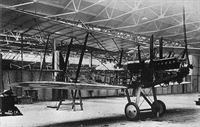Фотографии
-
AID Data Books and Rigging Manuals have become collector’s items, as have the associated photographs. To present the R.E.8 frontal view in flying position, the tail was mounted on a trestle which, in this photograph, has been deleted rather inexpertly from the negative.
Самолёты на фотографии: RAF R.E.8 - Великобритания - 1916
-
Aircraft controls were inspected at this stage of construction, before the fuselage was covered. Seen here is an R.E.8 at the Standard Motor Company’s Coventry works, December 22, 1917.
Самолёты на фотографии: RAF R.E.8 - Великобритания - 1916
-
Регистрационный номер: C6414 S.E.5as under construction at Wolseley Motors show the state of airframe and engine complexity by 1918. The youngsters working on the aircraft are indicative of the dilution of labour.
Самолёты на фотографии: RAF S.E.5 - Великобритания - 1916
-
Регистрационный номер: C1479 A specialist branch of the AID dealt with dopes and finishes. Late in the First World War the overall doping scheme was indicated by letters on the rudder, in this case “CD” for Cellon Scheme D.
Самолёты на фотографии: Sopwith Pup - Великобритания - 1916
-
A complaint to the AID in 1917 stated that engine bearers of the Sopwith Pup were weak, as they broke when the aircraft tilted up on its nose - a fairly frequent occurrence. The official reply was that this was fortuitous, as it prevented greater damage to the engine!
Самолёты на фотографии: Sopwith Pup - Великобритания - 1916
Статьи
- -
- Bell P-63 Kingcobra "42-68864" /Preservation Profile/
- Personal album. Military
- Skywriters
- B.Grimstead - Riding the Ryan PT-22
- B.Jones - Short's three degrees /British post-war experimental jet aircraft/ (10)
- B.Robertson - An AID to quality (1)
- C.Prower - From Brisfit to Beverley: Tailless experimentals (7)
- H.Levy - Darden's Dolphin
- H.Shore - Flea fever (1)
- J.Stroud - S.E.2010 Armagnac /Post-war propliners/
- M.Oakey - Grapevine
- M.Retallack - Mastering the Meteor (2)
- O.Thetford - By day and by night: Horsleys in service
- R.Riding - A dream fulfilled
- T.Nelson - Falling stars (2)




